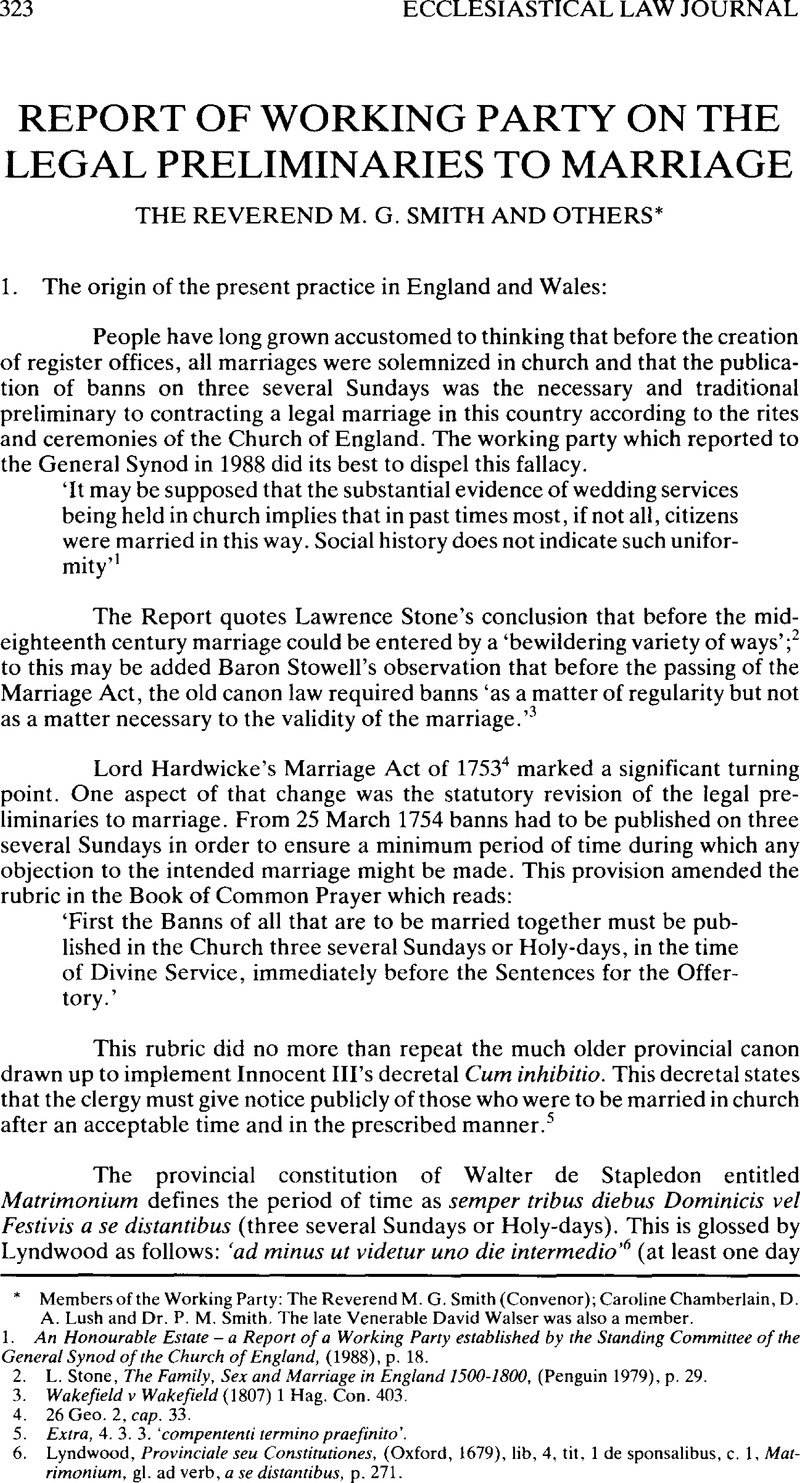No CrossRef data available.
Article contents
Report of Working Party on the Legal Preliminaries to Marriage
Published online by Cambridge University Press: 31 July 2008
Abstract

- Type
- Working party reports
- Information
- Copyright
- Copyright © Ecclesiastical Law Society 1995
References
1. An Honourable Estate – a Report of a Working Party established by the standing Committee of the General Synod of thye Church of England, (1988), p. 18.Google Scholar
2. Stone, L., The Family, Sex and Marriage in England 1500–1800, (Penguin 1979), p. 29.Google Scholar
3. Wakefield v Wakefield (1807) 1 Hag. Con. 403.Google Scholar
4. 26 Geo. 2, cap. 33.
5. Extra, 4. 3. 3. ‘compententi termino praefinito’.
6. Lyndwood, , Provinciale seu Constitutiones, (Oxford, 1679)Google Scholar, lib, 4, tit, 1 de sponsalibus, c. 1, Matrimonium, gl. ad verb, a se distantibus, p. 271.
7. In the opinion of Henry Fox this was a good reason for opposing the Bill in the Commons, see Parliamentary History, XV, 70.Google Scholar
8. King v The Inhabitants of Billingshurst (1814) 3 M & S. 255Google Scholar. Unfortunately the name of the case is not given.
9. Decretum Gratiani C33, q. 4 cc. 8–11 especially c. 10 ‘Non oportet a Septuagesima usque in octavo Paschae, et tribus hebdomanibus ante festivitatem sancti Iohannis Baptistae, et ab Adventu Domini usque post Epiphaniam nuptias celebrare. Quod si factum fuerit, separentur’. See also, Extra, 2, 9, 4; Lyndwood, op. cit., lib. 4, tit. 3, de clandestina desp., c. 1, Quia ex Contractibus, gl.ad verb, solemnizationem, p. 274Google Scholar; Bingham, Joseph, Origines Ecclesiasticae: or the Antiquities of the Christian Church, (London, 1722), vol. 9, pp. 337–338.Google Scholar
10. Gibson, E., Codex Ecclesiastic! Anglicani, 2nd edit. (1763), 1Google Scholar, 430, note z.
11. Johnson, J., The Clergy-man's Vade-Mecum, 1st. edit., (1706), p. 160Google Scholar. There are some incumbents who still observe this rule in 1994.
12. ‘And moreover he may grant … licences … for solemnizing matrimony without the publication of banns or at any season of the year otherwise prohibited.’ Parliamentary Papers: Ecclesiastical Courts Commission (1883), II, 676.Google Scholar
13. 26 Geo. 2 c.33 s.6; 6 & 7 Will. 4 c.85 s.1; 12, 13, & 14 Geo. 6 c.76 ss.5(b), 79(6).
14. However we have been shown a common licence issued by Archbishop Fisher to a couple in the Diocese of Exeter in July 1952.
15. Smith, P. M., ‘I publish the Banns of Marriage’, Modern Churchman, 12 (1969), p. 299.CrossRefGoogle Scholar
16. ‘ut intra ilium qui voluerit & valuerit, legitimum impedimentum opponat, & ipsi presbyteri nihilominus investigent, utrum aliquod impedimentum obsistat’.
17. But Canon B33 implies otherwise.
18. supra King v The Inhabitants of Billingshurst (1814), 257.Google Scholar
19. 19 & 20 Vict., cap. 119 and 6 & 7 Will. 4, cap. 85.
20. Holmes v Simmons (1868), L.R. 1 P. & D. 523; 18 L.T. 771.
21. Frankland v Nicholson (1805) M. & S. 260.
22. Stevenson, Kenneth & Spinks, Brian, The Identity of Anglican Worship, (1991), pp. 103–115.Google Scholar
23. General Synod Report Misc. 25.
24. op. cit., p. 74.
25. Ecc. L.J. (3) 14.
26. Ecc. L.J. (11) 359–368.
27. White Paper (January 1990) para. 3.15.
28. Coriden, James A., An Introduction to Canon Law, (Paulist Press 1991), p.4.Google Scholar
29. The Government White Paper (1990) para. 3.11 proposed abolition of the requirement that notices of intention to marry be posted in register offices. The Working Party looked at the suggestion that for banns should be substituted a simplified form of publication in a local newspaper as a means of fulfilling legal preliminaries but rejected it on the theological and liturgical grounds given above.
30. It is worth pointing out that it will be not only the parochial fees prepared by the Church Commissioners under the Ecclesiastical Fees Measure 1986 that are at issue here. Organists, bellringers, vergers and choirs all stand to lose, not to mention the collection plate!
31. Johnson, op. cit., p.159, where he takes it for granted that fees are due to the woman's parish church whether she is married there or not. This was certainly the custom in the diocese of Canterbury; see Court, Canterbury Consistory, Jones v Cheesman (1674)Google Scholar, Kent Record office PRC44/1.
32. Anglican Marriage in England and Wales: a Guide to the Law for Clergy, 1992, s.5.6; cf. Moore, Garth: ‘It is however worth noting that residence is a condition precedent to the publication of banns, and that residence does not occur simply by leaving a suitcase in the parish.’ An Introduction to English Canon Law, Oxford, 1967, p.87.Google Scholar
33. It would be understood that a surrogate did not handle applications for his own church or churches. If this proposal were to include the Church in Wales then it may be thought necessary to exclude the incumbent of Hawarden from this extension of the grant of the common licence.
34. Pearce, C. A. A., ‘The roles of the Vicar-general and Surrogate in the Granting of Marriage Licences’, 2 Ecc.L.J. 28–36.Google Scholar




